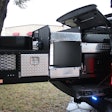Matching up an officer with a dog is just the first step in starting a successful K-9 team. Determine your current needs first. Why do you need to have a trained police service dog (PSD)? Are you having a problem with burglaries and the time it takes to search and clear the buildings with officers? If so, you can justify the savings in man-hours and units out of service through quicker and thorough searches by the PSD team. Are you looking for a dog to detect the odor of drugs for drug interdiction and searches? Do you need the application of a trained dog to add to your department's use-of-force scale for apprehensions and handler protection? Perhaps you need a dog to detect the odor of explosives or human remains.
Future needs should also be studied. What kinds od demands will be placed on your agency five years from now, and can a trained dog help deal with those problems? A single- purpose dog, as the name implies, is trained in one specialty area such as patrol work (apprehension, tracking, and searching or detection work of either explosives, narcotics or cadavers). What are commonly called dual- purpose dogs give the department more bang for its buck. The most common type of dual- purpose dog is a combination of drug- or bomb-detector dog and patrol dog. This type of K-9 will require more training time for the handler and dog to maintain their skills. And it will cost the department more up front if the animal is purchased from a reputable importer or a certified breeder.
Trying to make the K-9 unit an all-purpose team can go too far, as one state conservation department found out. The agency was looking at equipping all of the field agents with dogs to assist them in carrying out their duties. They wanted their dogs to be trained in handler protection, tracking, drug detection, cadaver recovery and fish and game detecting for poachers. Not only was it too much for the dogs to learn, but the handlers would be spending all their time training and not enforcing the law.
The Cost Factor
Once you have defined your needs, the biggest hurdle to clear will be cost. If you are making a sales pitch for developing a K-9 unit, be prepared to list in a line-item format what the start- up costs will be, as well as projected costs per year after start- up. Some issues to cover in detail to your administrators will be purchase price of the dog, equipment, transportation, food, vet and training. Be value conscious. Bargains can be found, but cheaper is not always better. For example, a well-meaning citizen who wants to donate an overly aggressive pet to the department may sound like a good deal, but it may cost you more in the long run. On the other hand, if you have $10,000 to spend on the purchase of the dog, you can rest assured that there will be someone out there who will be happy to take your money.
The next problem is deciding where the money will come from? If the funds are not budgeted, there are some alternate sources you may consider. Find a knowledgeable person who can look at donated dogs or dog rescued from the humane shelter for the right temperament and characteristics of a police-work dog. Some of the best dogs I've seen have come from these sources. U.S. Customs has trained dogs from these types of backgrounds for years. Some departments have solicited funds from community resources and civic interest groups. One department has sold "common stock" to purchase the dog and necessary equipment.
If you choose to purchase a dog, you still have some options available to you. An untrained dog will be cheaper to buy but will cost you in man- hours. The advantage, however, is that it gives you the opportunity to train the dog exactly as you would like to meet the needs of the department. This also gives you time to really observe the dog's behaviors. This includes strengths and weaknesses of the dog, as well as how the handler/ trainer relationship is developing. A trained dog will cost you more up front but may save you in training time. A popular marketing move by importers is to provide the agency with a fully- trained dog as well as handler training for a one- or two- week period. This looks inviting to administrators who are looking for ways to save dollars. Unfortunately, most experienced trainers will tell you that it takes longer than one or two weeks to train the handler to work with and trust the dog. It may take longer for you to see the results on the street until the dog and handler learn to work together and trust each other.[PAGEBREAK]
Buyer Beware
The bottom line on purchasing dogs is let the buyer beware. There are many people engaged in the business of importing and selling dogs. Most are professional and make sure you and your agency get the best dog possible for the money. Many will take a dog back for no charge and replace it with another if the department finds the dog unsuitable. However, there are some people in the business that are just after the municipal dollars and will take advantage of any lack of knowledge you have.
In an effort to get more out of the dog, some departments try to have two or more handlers for each dog. When one handler gets off work, the next handler picks up the dog for a second tour. This means the dog puts in 16- or 18- hour days, seven days a week. It makes sense on paper, but I have yet to talk to a handler that felt that this was good for the dog. The dog needs time off too, and while there is some logic to this practice, it is not recommended.
Food and vet expenses must be addressed. A talented, dedicated vet who has interest and experience in working with police service dogs will be a true asset to find. Because of the risks and dangerous work environment, the dog will be exposed to all sorts of potential illness and injuries such as high falls, cold and heat injuries, snakebites, gunshot wounds, stabbings, chemical poisoning and drug ingestion. A vet who has experience in these areas and is available 24 hours a day is a must. Be prepared to look and pay for the best.
The same holds true for food. Be prepared to pay for food and supplements that will take care of the high- energy needs of the dog. You can buy a 40- pound bag of generic dog food from any large department store for $4, but will it meet your animals' needs? Ask your vet and seek guidance from other handlers about what they feed their dogs and why. You should be able to arrange for a departmental discount for bulk purchase and tax- exempt status.
The amount of time you will spend in care, feeding, maintenance and training is a big issue with agencies. Being a dog handler is a 24- hour-a-day, seven-days-a-week, 365- days-of-the-year job. You are still responsible for care and feeding of your dog on your days off. How much time is fair to reimburse you is open to negotiation with the agency. Understand that you will put in far more hours than you will ever get reimbursed for as a handler. Be reasonable and realistic. Many good programs have lost community support and been removed from the department because a few handlers go over-zealous in their pursuit of overtime dollars.
Training hours are another critical issue. How much is enough? Eight hours per week is great if you are in a large department and have someone to help in your skill maintenance training. Four hours per week might be more realistic, but anything less than that is not recommended. This is especially true if you are working a dual- purpose dog. Your state may mandate how much training is needed for recertification every year. Check and project how much time will be necessary before you obtain the dog because that will also need to be worked into the budget.
Administrative Details
Without written directives and support from the command echelon, a dog unit may be useless. Policy and procedure must be written, tried out and adapted to the needs of the individual agency. Rules and regulations must be developed and adhered to. Check with neighboring departments that have a successful PSD program, and get copies of their written directives, procedures and forms. There is no sense in reinventing the wheel if you can find others who have already done it for you. Read these items well. Do not simply put your department seal on the top of the page and adopt what someone else is doing without careful study first. The directives written for a 40- dog unit may not fit your situation.
If you have an apprehension dog, where will the chief or sheriff place the dog in the agency's use-of-force scale? There are some great legal cases that have resulted in some interesting case law, depending on your Federal Circuit or State Court. Research legal issues carefully, as it will be your responsibility to educate others in your agency when and how the dog may be used within the agency's use-of-force continuum. Many department heads still have visions of how they saw dogs used as crowd control tools in the civil unrest period of the 1960s or had experiences with military working dogs while overseas. One organization that can help you win researching legal issues is the United States Police Canine Association (USPCA). For those of you with access to the Internet, the Federal Judicial Center at http://www.fjc.gov/ has a searchable database by topic and keyword of Supreme Court decisions. Use the law to articulate legal facts to support your positions.
Police work is nothing without forms and statistics to be kept. We howl and moan about all the paperwork in our line of work, but these same statistics will help you justify an increase in your budget and in the potential size of your unit. Key statistics to be kept are apprehension, finds, searches without finds or apprehensions, drug seized, drug tainted currency searches and use of force. There are a host of others, but these will get you started. Once again, talk to other in your area and see what kind of statistics and samples of forms you can obtain.
Starting a K-9 unit is more complicated than just getting a dog and matching it up with a police officer. It takes research, talking to others, patience and negotiating skills to make your vision come true.
Additional information about K-9s may be found on the Internet at CopNet or Canine Web.
John E. Hinton is an instructor with the Institute of Police Technology and Management (IPTM) in Jacksonville, Fla.












